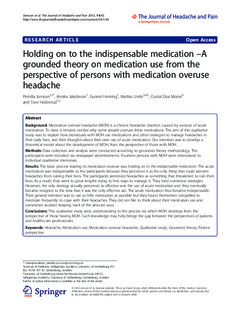| dc.contributor.author | Jonsson, Pernilla | |
| dc.contributor.author | Jakobsson, Annika | |
| dc.contributor.author | Hensing, Gunnel | |
| dc.contributor.author | Linde, Mattias | |
| dc.contributor.author | Moore, Crystal Dea | |
| dc.contributor.author | Hedenrud, Tove | |
| dc.date.accessioned | 2019-10-25T08:35:46Z | |
| dc.date.available | 2019-10-25T08:35:46Z | |
| dc.date.created | 2013-09-06T21:22:37Z | |
| dc.date.issued | 2013 | |
| dc.identifier.citation | The Journal of Headache and Pain. 2013, 14:43 . | nb_NO |
| dc.identifier.issn | 1129-2369 | |
| dc.identifier.uri | http://hdl.handle.net/11250/2624370 | |
| dc.description.abstract | Background
Medication overuse headache (MOH) is a chronic headache disorder, caused by overuse of acute medication. To date, it remains unclear why some people overuse these medications. The aim of this qualitative study was to explore how individuals with MOH use medications and other strategies to manage headaches in their daily lives, and their thoughts about their own use of acute medication. Our intention was to develop a theoretical model about the development of MOH, from the perspective of those with MOH.
Methods
Data collection and analysis were conducted according to grounded theory methodology. The participants were recruited via newspaper advertisements. Fourteen persons with MOH were interviewed in individual qualitative interviews.
Results
The basic process leading to medication overuse was holding on to the indispensable medication. The acute medication was indispensable to the participants because they perceived it as the only thing that could prevent headaches from ruining their lives. The participants perceived headaches as something that threatened to ruin their lives. As a result, they went to great lengths trying to find ways to manage it. They tried numerous strategies. However, the only strategy actually perceived as effective was the use of acute medication and they eventually became resigned to the idea that it was the only effective aid. The acute medication thus became indispensable. Their general intention was to use as little medication as possible but they found themselves compelled to medicate frequently to cope with their headaches. They did not like to think about their medication use and sometimes avoided keeping track of the amount used.
Conclusions
This qualitative study adds understanding to the process via which MOH develops from the perspective of those having MOH. Such knowledge may help bridge the gap between the perspectives of patients and health-care professionals. | nb_NO |
| dc.language.iso | eng | nb_NO |
| dc.publisher | BMC (part of Springer Nature) | nb_NO |
| dc.rights | Navngivelse 4.0 Internasjonal | * |
| dc.rights.uri | http://creativecommons.org/licenses/by/4.0/deed.no | * |
| dc.title | Holding on to the indispensable medication - A grounded theory on medication use from the perspective of persons with medication overuse headache | nb_NO |
| dc.type | Journal article | nb_NO |
| dc.type | Peer reviewed | nb_NO |
| dc.description.version | publishedVersion | nb_NO |
| dc.source.pagenumber | 11 | nb_NO |
| dc.source.volume | 14:43 | nb_NO |
| dc.source.journal | The Journal of Headache and Pain | nb_NO |
| dc.identifier.doi | 10.1186/1129-2377-14-43 | |
| dc.identifier.cristin | 1047599 | |
| dc.description.localcode | © 2013 Jonsson et al.; licensee Springer. This is an Open Access article distributed under the terms of the Creative Commons Attribution License (http://creativecommons.org/licenses/by/2.0), which permits unrestricted use, distribution, and reproduction in any medium, provided the original work is properly cited. | nb_NO |
| cristin.unitcode | 194,65,30,0 | |
| cristin.unitcode | 1920,16,0,0 | |
| cristin.unitname | Institutt for nevromedisin og bevegelsesvitenskap | |
| cristin.unitname | Nevroklinikken | |
| cristin.ispublished | true | |
| cristin.fulltext | original | |
| cristin.qualitycode | 1 | |

